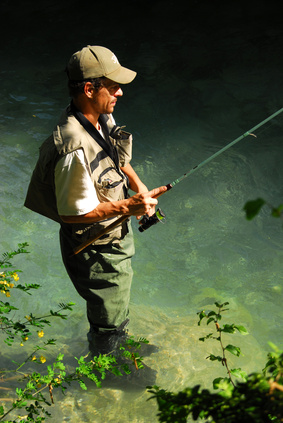Ultralight Fishing Smallmouth Bass
 I have often read about ultralight fishing for smallmouth bass and how much some people enjoy it but I always worried about the fish breaking my line and then swimming around iwth my lure in their mouth for an eternity. This article helped me understand the benefits of ultralight fishing, the biggest of which is catching more bass!
I have often read about ultralight fishing for smallmouth bass and how much some people enjoy it but I always worried about the fish breaking my line and then swimming around iwth my lure in their mouth for an eternity. This article helped me understand the benefits of ultralight fishing, the biggest of which is catching more bass!
Ultralight fishing for smallmouth bass
Ultra-light means different things to different people. To me, it means a 6- to 7-foot rod that weighs only three or four ounces with a very soft tip. The reel is of the open-faced type, designed for four- to eight-pound test line. I never use the eight-pound line, relying on either four- or six-pound test and in the monofilament variety.
With this rig, I can easily cast lures weighing as little as 1/16- to 1/8-ounce. There are those who live by the old adage, “ It takes a big lure to catch a big fish.” This isn’t always accurate. Sure, you might lose a few lunkers that might have been landed on heavier tackle, but experience has shown that one can often catch five to 10 times more fish by using ultra-light tackle.
During summers like this one, many lakes and ponds tend to become gin-clear, making it easier for fish to spot heavy lines. The four- and six-pound lines, in most cases, are nearly invisible to fish, even in very clear water.
The reel must have a drag system that works well and does not freeze up. This is essential because a big fish can easily break the light line if the drag doesn’t work properly.
If you have never tried ultra-light fishing, you are in store for a treat — not to mention that you will get more strikes. Read the original article by Emory Josey here.
You may be wondering what situations would be best to get started with ultralight fishing. There is some good advice here from BassPro.com
Situations for Using Ultra-Light
Ultra-light tackle and methods may be used anytime by anglers who find this style and philosophy of fishing appealing. However, there are a few special situations where ultra-light is also the most practical, most productive fishing method available. Specific examples include:
Where fishing pressure is heavy — Heavily pressured fish get spooky, and they become less likely to bite large, fast moving baits. However, they are much more prone to eat lures that are inconspicuous in terms of size and action. Finesse pays off in heavily fished areas.
Waters that are extremely clear — Crystal clear water is another condition that makes fish spooky. Thin line is less visible, and smaller baits are more visible, and smaller baits are less threatening, hence more appealing, than larger lures with abrasive actions.
Post-cold front conditions — When a cold front blows through and the barometer rises, bass get uncomfortable, much like a human with indigestion. Offer him a steak, and he will turn it down flat. But pass a spoon of vanilla ice cream in front of him, and he’ll probably take it. Ultra-light is the vanilla ice cream of fishing.
When natural forage is small — Sometimes, when minnows or insects are small, predator fish refuse to bite larger baits, but ultra-light lures which approximate the size of the natural food will still work.
And finally…Don’t Forget the Pliers
One must-have accessory for ultra-light fishing is a pair of needlenose pliers, or some type fisherman’s tool with pliers included. Source
These tips are very helpful because with lower summer flows, we’ll see some gin-clear water and fishing ultralight might help us land more smallmouth bass.
Next time you go to hit the water, especially if conditions are tough and the fish have shut down, remember to try ultralight fishing for smallmouth bass and see how you do. Sign up for our news, tips and videos here: click here

